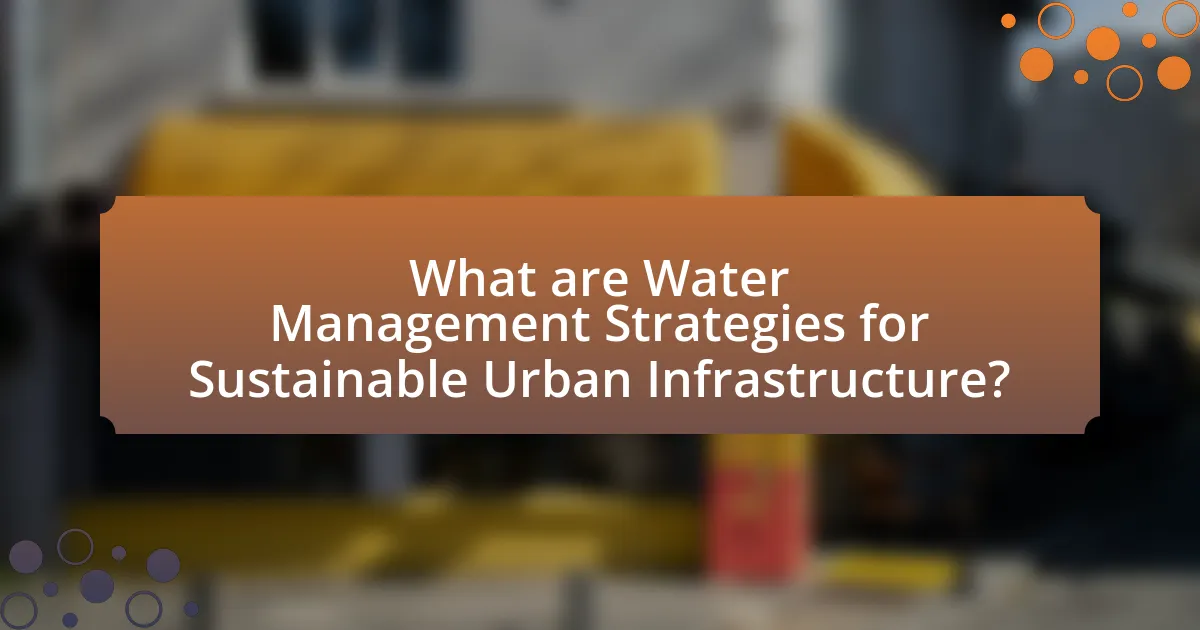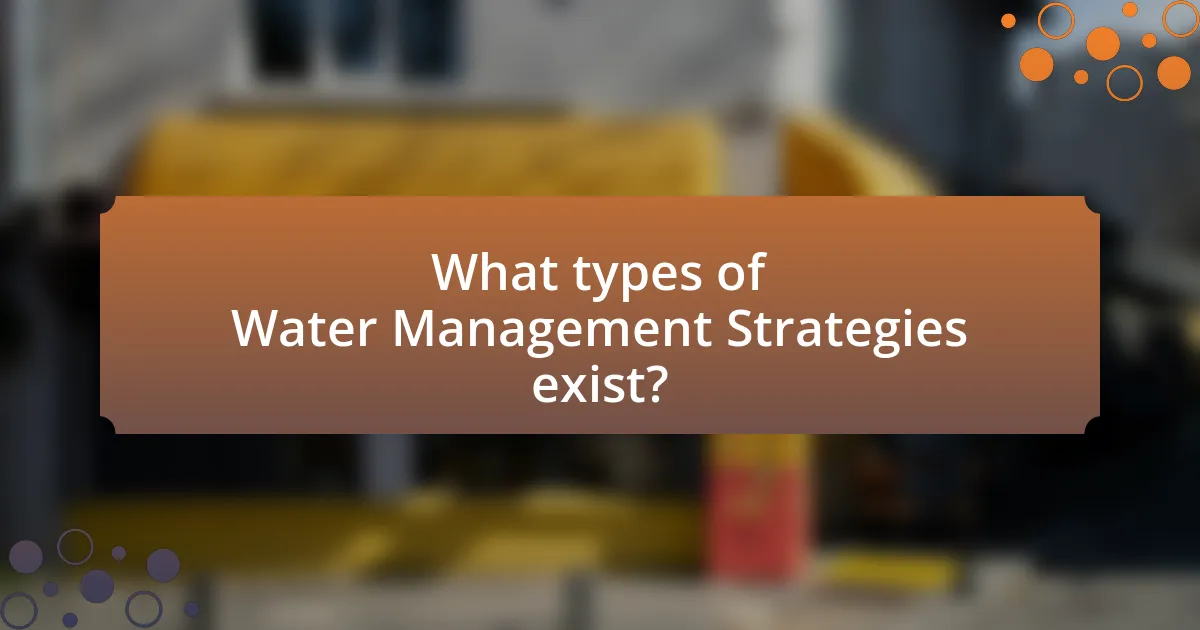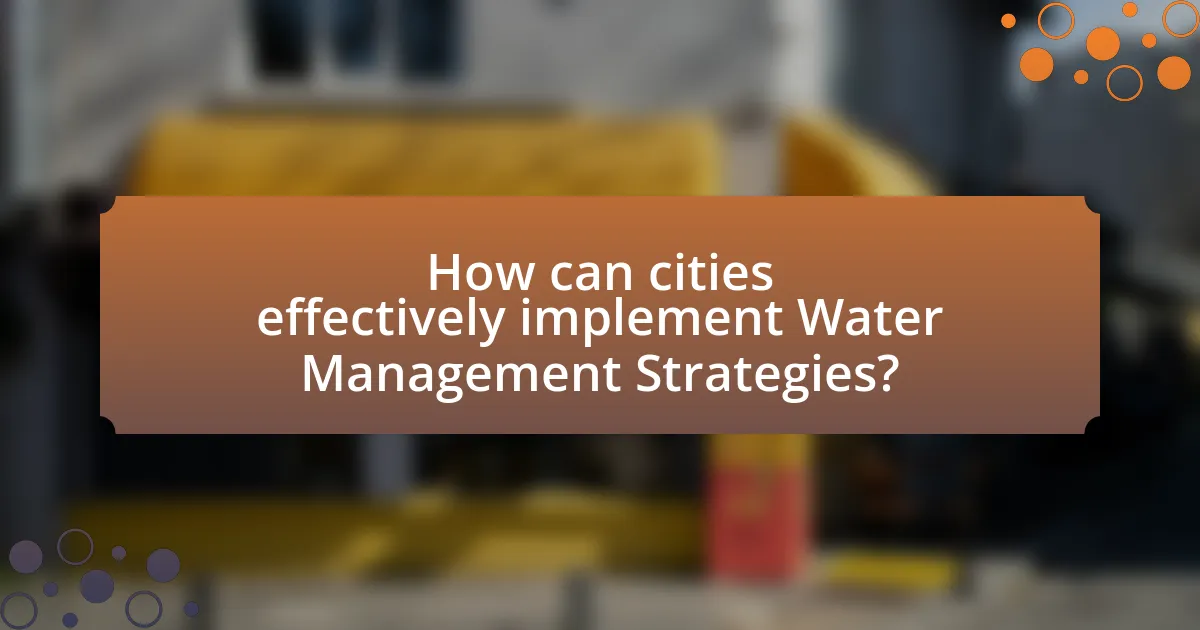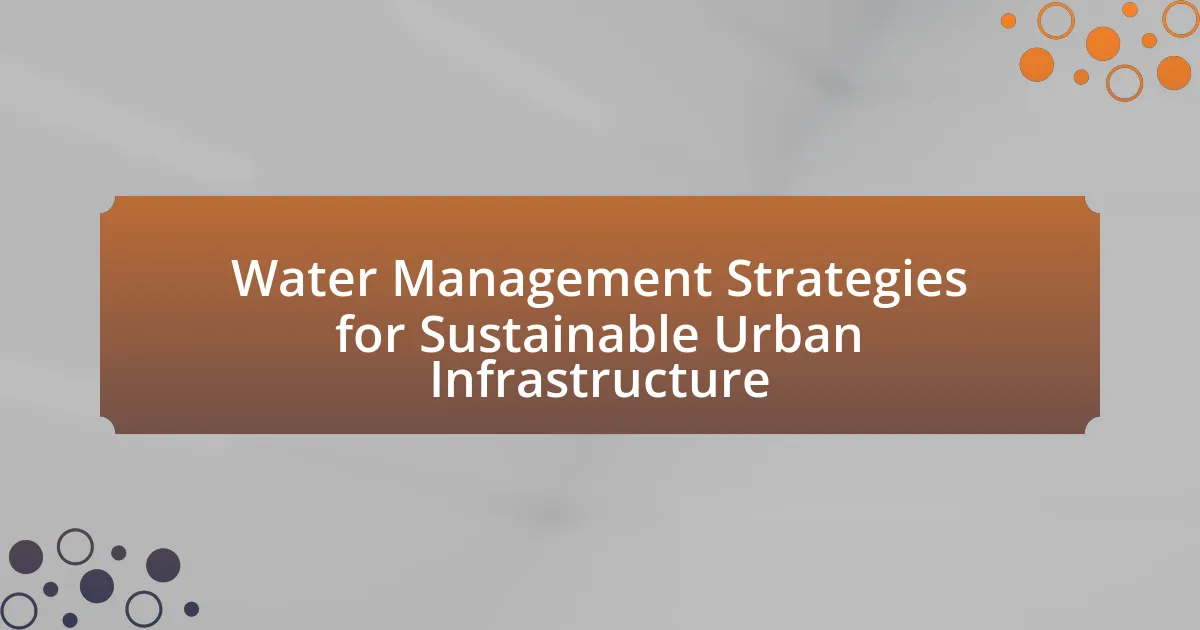Water management strategies for sustainable urban infrastructure encompass integrated water resource management, rainwater harvesting, wastewater recycling, and green infrastructure. These strategies aim to optimize water use, reduce waste, and enhance ecosystem health, contributing to urban sustainability. Key principles include conservation, stakeholder participation, and the coordinated management of water and land resources. Challenges such as financial constraints, regulatory complexities, and public engagement issues hinder implementation. The article also explores the impact of climate change and population growth on water management, the role of technology, and best practices for integrating these strategies into urban planning.

What are Water Management Strategies for Sustainable Urban Infrastructure?
Water management strategies for sustainable urban infrastructure include integrated water resource management, rainwater harvesting, wastewater recycling, and green infrastructure. Integrated water resource management promotes the coordinated development and management of water, land, and related resources to maximize economic and social welfare without compromising the sustainability of ecosystems. Rainwater harvesting captures and utilizes rainwater for various purposes, reducing reliance on traditional water sources. Wastewater recycling treats and reuses wastewater for irrigation and industrial processes, conserving freshwater resources. Green infrastructure, such as permeable pavements and green roofs, enhances stormwater management and reduces urban flooding while improving water quality. These strategies collectively contribute to the resilience and sustainability of urban environments.
How do these strategies contribute to urban sustainability?
Water management strategies contribute to urban sustainability by optimizing the use of water resources, reducing waste, and enhancing ecosystem health. These strategies, such as rainwater harvesting, green infrastructure, and wastewater recycling, promote efficient water use and minimize the environmental impact of urbanization. For instance, implementing green roofs can reduce stormwater runoff by up to 50%, thereby decreasing the risk of flooding and improving water quality. Additionally, wastewater recycling can provide a sustainable water source, reducing reliance on freshwater supplies and promoting resilience against droughts. These practices not only support the sustainable management of water resources but also contribute to the overall health and livability of urban environments.
What are the key principles behind sustainable water management?
The key principles behind sustainable water management include integrated water resource management, conservation, and stakeholder participation. Integrated water resource management emphasizes the coordinated development and management of water, land, and related resources to maximize economic and social welfare without compromising the sustainability of vital ecosystems. Conservation focuses on the efficient use of water resources to reduce waste and protect water quality. Stakeholder participation involves engaging communities and various stakeholders in decision-making processes to ensure that water management strategies reflect local needs and conditions. These principles are supported by the United Nations’ Sustainable Development Goals, which highlight the importance of water management in achieving sustainability and resilience in urban infrastructure.
How do these principles apply to urban infrastructure?
The principles of water management strategies for sustainable urban infrastructure apply by promoting efficient use, conservation, and equitable distribution of water resources. These principles guide the design and implementation of systems such as green roofs, permeable pavements, and rainwater harvesting, which enhance water retention and reduce runoff. For instance, cities like Singapore have successfully integrated these strategies, resulting in a 30% reduction in stormwater runoff and improved water quality. This demonstrates that applying these principles not only addresses water scarcity but also enhances urban resilience against flooding and climate change impacts.
What challenges do cities face in implementing these strategies?
Cities face significant challenges in implementing water management strategies for sustainable urban infrastructure, primarily due to financial constraints, regulatory complexities, and public engagement issues. Financial constraints often limit the ability of municipalities to invest in necessary infrastructure upgrades and maintenance, with studies indicating that U.S. cities alone face a funding gap of approximately $123 billion for water infrastructure over the next decade. Regulatory complexities arise from the need to navigate multiple layers of local, state, and federal regulations, which can delay project approvals and increase costs. Additionally, public engagement issues can hinder the implementation process, as residents may resist changes due to a lack of understanding or perceived inconvenience, making it essential for cities to effectively communicate the benefits of these strategies to gain community support.
What are the common barriers to effective water management in urban areas?
Common barriers to effective water management in urban areas include inadequate infrastructure, regulatory challenges, and financial constraints. Inadequate infrastructure often leads to inefficiencies in water distribution and increased leakage rates, which can exceed 30% in some cities. Regulatory challenges arise from fragmented governance structures that complicate decision-making and hinder coordinated efforts. Financial constraints limit investment in necessary upgrades and maintenance, with many municipalities facing budget shortfalls that prevent the implementation of sustainable practices. These barriers collectively impede the ability to manage water resources effectively, resulting in water scarcity and environmental degradation.
How do climate change and population growth impact water management?
Climate change and population growth significantly strain water management systems. Climate change leads to altered precipitation patterns, increased evaporation rates, and more frequent extreme weather events, which can result in water scarcity and flooding. For instance, the Intergovernmental Panel on Climate Change (IPCC) reports that global warming is expected to increase the frequency of droughts in many regions, directly impacting water availability.
Simultaneously, population growth escalates water demand, particularly in urban areas, where more people require water for drinking, sanitation, and agriculture. According to the United Nations, the global population is projected to reach 9.7 billion by 2050, intensifying competition for limited water resources. This combination of increased demand and reduced supply complicates effective water management, necessitating innovative strategies to ensure sustainable urban infrastructure.

What types of Water Management Strategies exist?
There are several types of water management strategies, including integrated water resources management, demand management, stormwater management, wastewater treatment and reuse, and conservation practices. Integrated water resources management focuses on the coordinated development and management of water, land, and related resources to maximize economic and social welfare without compromising the sustainability of ecosystems. Demand management involves strategies to reduce water consumption through efficiency measures and behavioral changes. Stormwater management addresses the control and treatment of runoff to prevent flooding and pollution. Wastewater treatment and reuse strategies aim to treat and recycle wastewater for various uses, thereby conserving freshwater resources. Conservation practices promote the sustainable use of water through measures such as xeriscaping and rainwater harvesting. These strategies are essential for ensuring sustainable urban infrastructure and addressing challenges related to water scarcity and quality.
How do green infrastructure solutions enhance water management?
Green infrastructure solutions enhance water management by utilizing natural processes to manage stormwater, reduce flooding, and improve water quality. These solutions, such as green roofs, permeable pavements, and rain gardens, absorb and filter rainwater, thereby decreasing runoff and promoting groundwater recharge. For instance, a study by the U.S. Environmental Protection Agency found that green infrastructure can reduce stormwater runoff by up to 65%, significantly mitigating the risk of urban flooding. Additionally, these systems improve water quality by filtering pollutants, as demonstrated in research published in the journal “Water Research,” which showed that bioretention systems can remove over 80% of total suspended solids from stormwater.
What are examples of green roofs and permeable pavements?
Examples of green roofs include the Chicago City Hall Green Roof, which features a variety of native plants and helps reduce urban heat, and the Bosco Verticale in Milan, known for its extensive vegetation that improves air quality. Permeable pavements are exemplified by the use of permeable concrete in parking lots, such as the one at the University of New Hampshire, which allows rainwater to infiltrate and recharge groundwater, and permeable interlocking concrete pavers used in residential driveways that manage stormwater runoff effectively. These examples illustrate how green roofs and permeable pavements contribute to sustainable urban infrastructure by enhancing water management and promoting environmental benefits.
How do these solutions mitigate urban flooding?
Solutions mitigate urban flooding by implementing effective water management strategies that enhance drainage capacity and reduce runoff. These strategies include the installation of permeable pavements, which allow water to infiltrate the ground, and the creation of green roofs that absorb rainwater. Additionally, the construction of retention basins captures excess stormwater, preventing it from overwhelming drainage systems. Research indicates that cities employing these methods have experienced a significant reduction in flood events, with studies showing up to a 30% decrease in surface runoff during heavy rainfall.
What role does technology play in water management strategies?
Technology plays a crucial role in water management strategies by enhancing efficiency, monitoring, and decision-making processes. Advanced technologies such as remote sensing, geographic information systems (GIS), and smart water meters enable real-time data collection and analysis, allowing for better resource allocation and leak detection. For instance, the use of IoT devices in urban water systems can reduce water loss by up to 30% through timely alerts on leaks and irregular consumption patterns. Additionally, data analytics and modeling tools facilitate predictive maintenance and optimize water distribution networks, ultimately leading to sustainable urban infrastructure.
How can smart water systems improve efficiency?
Smart water systems improve efficiency by utilizing advanced technologies such as IoT sensors, data analytics, and automated controls to optimize water distribution and usage. These systems enable real-time monitoring of water flow, pressure, and quality, allowing for immediate detection of leaks and inefficiencies. For instance, a study by the American Water Works Association found that smart water technologies can reduce water loss by up to 30%, significantly enhancing resource management. Additionally, predictive analytics can forecast demand patterns, leading to better allocation of water resources and reduced operational costs.
What technologies are emerging in urban water management?
Emerging technologies in urban water management include smart water meters, advanced data analytics, and decentralized water treatment systems. Smart water meters enable real-time monitoring of water usage, helping to identify leaks and optimize consumption. Advanced data analytics utilize big data and machine learning to predict water demand and manage resources more efficiently. Decentralized water treatment systems, such as membrane bioreactors and constructed wetlands, provide localized solutions for wastewater treatment, reducing the need for extensive infrastructure. These technologies collectively enhance the sustainability and efficiency of urban water management systems.

How can cities effectively implement Water Management Strategies?
Cities can effectively implement Water Management Strategies by adopting integrated approaches that combine technology, policy, and community engagement. For instance, the use of smart water management systems, which utilize sensors and data analytics, can optimize water distribution and reduce waste. A study by the World Bank indicates that cities employing such technologies can achieve up to 30% reductions in water loss. Additionally, implementing policies that promote rainwater harvesting and wastewater recycling can enhance water supply resilience. Evidence from cities like Singapore shows that comprehensive water management frameworks can lead to sustainable urban infrastructure, ensuring long-term water security and environmental protection.
What are best practices for integrating water management into urban planning?
Best practices for integrating water management into urban planning include implementing green infrastructure, utilizing integrated water resource management (IWRM), and promoting stakeholder engagement. Green infrastructure, such as permeable pavements and green roofs, enhances stormwater management and reduces runoff, as evidenced by studies showing a 30% reduction in urban flooding when such practices are adopted. IWRM ensures that water supply, quality, and ecosystem health are considered collectively, leading to more sustainable outcomes, supported by the United Nations’ guidelines on water management. Additionally, engaging stakeholders, including local communities and businesses, fosters collaboration and ensures that diverse perspectives are incorporated, which has been shown to improve project success rates by up to 50%.
How can stakeholder engagement enhance strategy effectiveness?
Stakeholder engagement enhances strategy effectiveness by fostering collaboration and ensuring that diverse perspectives are integrated into decision-making processes. Engaging stakeholders, such as community members, government agencies, and environmental organizations, leads to more comprehensive and informed strategies that address the needs and concerns of all parties involved. For instance, a study by the International Water Association found that projects with active stakeholder participation are 30% more likely to succeed in achieving their objectives compared to those without such engagement. This increased likelihood of success is attributed to improved trust, transparency, and shared ownership of the outcomes, which ultimately leads to more sustainable water management strategies in urban infrastructure.
What role do policies and regulations play in successful implementation?
Policies and regulations are critical for the successful implementation of water management strategies in sustainable urban infrastructure. They establish a framework that guides decision-making, resource allocation, and compliance with environmental standards. For instance, regulations can mandate the use of green infrastructure practices, such as rain gardens and permeable pavements, which enhance stormwater management and reduce urban flooding. Evidence from the U.S. Environmental Protection Agency indicates that cities with stringent water management policies experience improved water quality and reduced runoff, demonstrating the effectiveness of regulatory frameworks in achieving sustainable outcomes.
What are the economic implications of sustainable water management?
Sustainable water management has significant economic implications, primarily by reducing costs associated with water supply and treatment. Efficient water management practices can lead to lower operational costs for municipalities, as seen in cities that implement rainwater harvesting and wastewater recycling, which can reduce reliance on expensive water sources. For instance, the City of San Diego reported savings of approximately $1.5 million annually through its water reuse programs. Additionally, sustainable practices can enhance property values and attract businesses, as areas with reliable water resources are more appealing for investment. The World Bank estimates that every dollar invested in water management can yield up to $4 in economic returns, highlighting the financial benefits of sustainable approaches.
How can cities fund water management initiatives?
Cities can fund water management initiatives through a combination of public financing, grants, and innovative financing mechanisms. Public financing often includes budget allocations from local governments, while grants can be sourced from federal or state programs aimed at improving water infrastructure. For instance, the U.S. Environmental Protection Agency provides funding through the Clean Water State Revolving Fund, which has allocated billions to support water management projects across the country. Additionally, cities can explore public-private partnerships, which leverage private investment for infrastructure development, thereby reducing the financial burden on public funds. These strategies collectively enhance the financial capacity of cities to implement effective water management initiatives.
What are the long-term cost benefits of sustainable practices?
Sustainable practices in water management lead to significant long-term cost benefits by reducing operational expenses and enhancing resource efficiency. For instance, implementing rainwater harvesting systems can decrease reliance on municipal water supplies, resulting in lower water bills. Additionally, sustainable infrastructure, such as permeable pavements and green roofs, can mitigate stormwater runoff, reducing the need for expensive drainage systems and minimizing flood-related costs. According to a study by the American Society of Civil Engineers, investing in sustainable infrastructure can yield a return of up to $4 for every $1 spent due to reduced maintenance and operational costs. These practices not only lower immediate expenses but also contribute to long-term savings by promoting resilience against climate change impacts and preserving natural resources.
What practical steps can urban planners take to improve water management?
Urban planners can improve water management by implementing green infrastructure, such as rain gardens and permeable pavements, which enhance stormwater absorption and reduce runoff. These practices are supported by studies showing that green infrastructure can decrease urban flooding by up to 30% and improve water quality by filtering pollutants. Additionally, planners should integrate water-efficient technologies, like smart irrigation systems and greywater recycling, which can reduce water consumption by 20-50%. Evidence from cities that have adopted these technologies indicates significant savings in water usage and operational costs. Furthermore, urban planners should engage in community education and stakeholder collaboration to promote sustainable water practices, as community involvement has been shown to increase the effectiveness of water management initiatives.
How can cities assess their current water management practices?
Cities can assess their current water management practices by conducting comprehensive audits that evaluate infrastructure, water quality, and usage efficiency. These audits involve analyzing data on water consumption, leakage rates, and treatment processes to identify areas for improvement. For instance, the American Water Works Association reports that urban water systems can lose up to 30% of their water through leaks, highlighting the need for regular assessments. Additionally, cities can implement stakeholder engagement processes to gather community feedback on water services, which can provide insights into public satisfaction and areas needing enhancement. By utilizing these methods, cities can create a clear picture of their water management effectiveness and develop targeted strategies for improvement.
What strategies can be employed for continuous improvement in water management?
Strategies for continuous improvement in water management include implementing advanced technologies, enhancing stakeholder engagement, and adopting integrated water resource management practices. Advanced technologies, such as smart metering and real-time monitoring systems, enable efficient water usage and leak detection, leading to reduced waste. Enhanced stakeholder engagement fosters collaboration among government, communities, and businesses, ensuring that diverse perspectives inform water management decisions. Integrated water resource management practices promote a holistic approach, considering the interconnections between water supply, quality, and ecosystem health. These strategies are supported by evidence from various case studies, such as the successful implementation of smart water systems in cities like Barcelona, which reported a 25% reduction in water loss.
